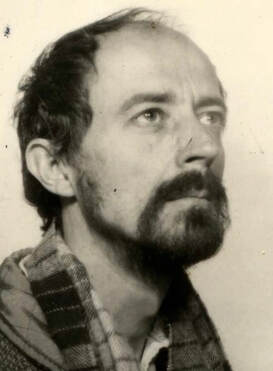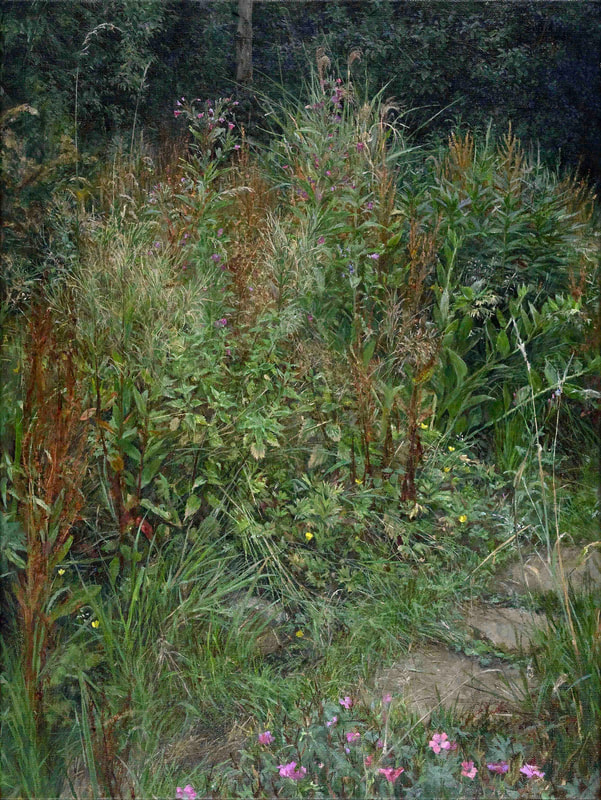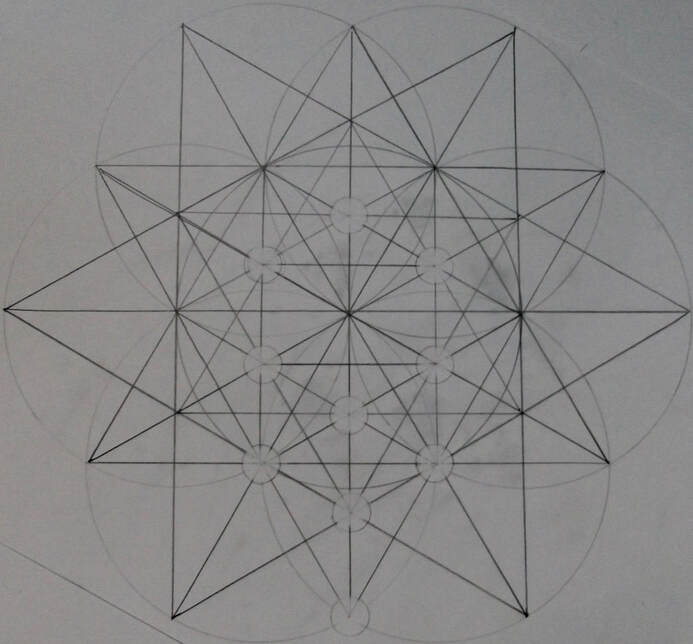|
Foreword by Cherry Gilchrist: This article is an extract from the website of the artist John Pearce, who originally encountered Kabbalah through Tony Potter’s group. In this extract John talks about his early experiences in the group, different versions of the Extended Tree or Jacob’s ladder diagram, and his own insight into the diagram as forming a ladder of 22 rungs.
There were a number of other art students at Hornsey and elsewhere, during the mid-60s, who were tipped off about the group meetings, including Eric ‘Light Wizard’ Cooper. As Eric recollected in an email to Rod Thorn: ‘In 1962 l was studying stained glass at Hornsey College of Art. One of my tutors there, one Stanley Pelter, for some reason invited me to attend a meeting one evening at a nearby address. When I arrived, Rosemary [Potter] opened the door went back inside, and apparently said, "It's him!" and I'm still working out what she meant.’ After college, John became established as a professional artist and teacher of art, and today lives in Crouch End, North London. He has exhibited his work widely, including at the Royal Academy, the National Portrait Gallery and Tate Britain. One of his paintings is on permanent display at the Guildhall Gallery, London. Our contact with John came about a few years ago, when he read a post about the group on Historical Sketches in Esoteric Britain, and sent in an account of his own experiences. Since then we’ve conferred with him both on the history of the groups, and on Kabbalistic diagrams and philosophy. In 2019 John was also able to visit Glyn’s wife and daughter in the same flat in Maida Vale where he briefly met Glyn many years ago, and as he describes below. He also made some preliminary studies of the garden there, for one of his very detailed paintings. (An example from another painting is shown below.) We are reminded that sometimes the wheel turns, and comes full circle again! Finding The Ladder In the late 1960s, for various reasons the Highgate group began to founder. Seeking to ensure continuity, the founding fathers of the preceding “Society of the Common Life” which existed in 1950s Soho, began to appear in Highgate. The leading lights were Alan Bain, whom Tony had always acknowledged as his teacher, Wilfred Glyn Davies (Glyn), and Robin Amis. All these (now dead) esotericists in their different ways devoted their lifetime to The Work. Robin Amis’ interest and subsequent career wasn’t particularly Kabbalistic, being more influenced by the Gurdjieff/Ouspensky teaching known as The Fourth Way. After running a summer school in The Forest of Dean with his artist wife, he went on to study esoteric Christianity with the Greek Orthodox monks on Mount Athos, and was later instrumental in translating Boris Mouravieff’s ponderous three volume work Gnôsis into English. Gnôsis describes a path of enlightenment based on esoteric Christianity and the medieval ideal of courtly love, which Mouravieff calls The fifth Way and says “It reveals the yearning of the human heart secretly lamenting its profound loneliness. This romance constitutes the essential goal of esoteric work.” Wilfred Glyn Davies had been introduced to Kabbalah by a mysterious John Smith whom he met while serving in the Royal Air Force. Smith would pass on his teaching only to a very few individuals at a time, and Glyn too was reticent about openly sharing his own esoteric discoveries. When I visited him in his Maida Vale flat on 23rd. March 1969, he consulted the Yi-Ching oracle before showing me the large pieces of paper on which he was constructing what he called ‘The Greater Diagrams’ – versions of what came to be called ‘Jacob’s Ladder’ or ‘The Extended Tree’. This interlaced four Kabbalah Trees of Life, one in each of the ‘Four Worlds’, and was typical of what some group members affectionately referred to as a ‘Glynthesis’. Cherry Gilchrist and Warren Kenton, both members of a study group Glyn formed in 1970, have both written about the occasion when a version of ‘The Greater Diagram’, was revealed by Glyn in 1972. In his The Path of a Kabbalist: An Autobiography (Kabbalah Society; Tree of Life Publishing UK, 2009) Warren describes it as ‘a rediscovery’, and refers to Glyn only as ‘my instructor’. He writes: “Suddenly Jacob’s Ladder was there with the Great Tree on the central column. When the Kabbalah group was shown this scheme, we were stunned.” Gilchrist writes: “In this Tree, the Kether of the lower Tree becomes the Tiferet of the next higher one, and there are nine Sefirot down the right and left pillars, and ten (plus the ‘invisible’ sefira of Daath) down the centre.” (See 'The Extended Tree') This is, in effect, a geometrical representation of the reunited totality of the human being, divided since the Fall. Coincidentally it parallels Moravieff’s ‘essential goal of esoteric work.’ Warren was soon to adopt Jacob’s ladder, becoming a well-known and respected teacher and prolific writer on Kabbalah, using his Hebraic name Z’ev ben Shimon Halevi. His version of Kabbalah, largely based on The Extended Tree as well as his own researches in what he calls ‘The Toledano Tradition’ is now almost as influential and well-known as the Hermetic Tradition of the Golden Dawn. Of the numerous images of the extended tree that proliferate on the net, the great majority are based on Warren’s version, which in turn is based on Glyn’s. Alan Bain had also worked in terms of a Jacob’s Ladder diagram before 1970, and he too developed a system of Kabbalah teaching, but, unlike Warren Kenton, linked it with Tarot symbolism. This is published in a limited book edition and online as The Keys of Kabbalah. He read parts of the text to myself and other members of Tony Potter’s group in 1970 – not, at the time, to very great acclaim. To be honest, in all my brief encounters with The Extended Tree in the 1970s, including Warren’s publications, I felt there was something facile, specious and even exploitative about it. I was unaware of its originality, and felt the unextended form of the Tree to be quite complicated enough. Bain’s Extended Tree has two innovations not found in any other version: First, it includes the Three Veils of Negative Existence as three points above the level of emanation from Kether. This results in thirty-two points which Bain attributes to the Thirty-Two Paths of Wisdom described in an obscure, possibly 8th C text now invariably tacked-on to editions of the somewhat earlier Sepher Yetzirah (Book of Formation). Secondly, he is at pains to remove Daath from the ladder, on the grounds that the Sepher Yetzirah stipulates there are ten sephiroth, and not eleven. Not only do I feel that, sephira or not, the position of Daath arises from the geometry and cannot be dispensed with, but Alan’s addition of the ‘Three Veils’ actually results in twelve points “attached to” the central pillar. Presumably Bain wouldn’t have counted ‘Ain’ as a sephirah, so why worry about Daath? In my own version, which I called The Gnostic Ladder, I retain the Daath point, as well as the Three Veils. Why Daath cannot be excluded: construction based on seven equal circles, six interlaced on the circumference of the central circle, generating 12 segments, a series of hexagons and potentially 6 Trees of Life. The Daath point is the centre. And yet – Bain may have had good reason which we know not of. I remember once encountering an un-characteristically quiet Tony Potter standing off-centre in the bar room of The Red Lion and Sun. I asked him what he was doing and he said he was bending the Tree round and cramming all the sephiroth into his solar plexus. “Aren’t you being a bit rough with the Tree?” I said, but he answered “I’m rough with myself”. For Tony Potter, and probably for Bain, The Tree was made for mankind and not mankind for the Tree. The Glynthesis
Considering that everyone has referred to such a diagram as a ‘ladder’, it’s odd that no-one thought to draw in the rungs. As a Kabbalist, Alan Bain would surely have found it significant that, with or without Daath, there are twenty-two rungs, or levels, on his version of The Ladder, and on his alone. It’s early days and so far attempts to attribute a Hebrew letter, or a corresponding Tarot Trump, to each rung have been extremely tentative. The thirty two paths of The Sepher Yetzirah include the numbers from one to ten as the sephiroth, so it would be quite valid to consider the 22 rungs, corresponding to the Hebrew letters, as a structure which supports, underlies and also gives insight into the ten ‘Greater Sephiroth’. The fractal complexity of this might be inseparable from its elegance, but what it might mean in terms of human life and The Work has yet to be grasped. Perhaps it has been kept hidden for the very reason that, other than as an artefact of geometry, it actually has no significance? That, of course, is unthinkable in Kabbalah. Do carry on Reading…
John’s full article goes on to explore, among other things, how the Sepher Yetzirah, the Law of Three and the Tarot can support our understanding of the ladder. His other new article, ‘Cabalistic Conclusions’, is a speculative study of the attributions of the 22 rungs and 32 nodal points of the ladder. You may also be interested to read his ‘Art and Reality’ which focuses on Tony Potter and Barry Long, a teacher from a different tradition.
3 Comments
Dee Swift
28/6/2021 11:46:20 am
This was a really fascinating read and I also followed the article to John Pearce's website where he discussed his meetings with Barry Long. I have a couple of books by Long and it was interesting to read how his approach to guiding his group contrasted with Tony Potter's. I also enjoyed the comments about art and how Long wanted to dictate the form his portrait should take. John Pearce's portrait (having ignored him) I thought was rather good.
Reply
29/6/2021 04:11:14 pm
Thank you for your positive response, Dee. Interesting that you were also aware of Barry Long. I would say his teaching of meditation was very effective, but his sense of cosmic mission was dramatic and mind-blowing. I painted his portrait over many sittings after the death of his wife Julie, and at a time when he was extending his activities to a global level - not quite the same undercover ethos as the Tony Potter Group, though both flourished in Highgate. On one occasion they were in the Red Lion and Sun at the same time - though they didn't communicate.
Reply
Dee Swift
29/6/2021 06:22:09 pm
I'm still reading the other articles, so thank you. The one about Art & Reality attracted me because I have a personal interest in how the practice of drawing and painting intersects with meditation. But I'm onto the Cabalistic Conclusions one now! Thank you for providing much food for thought and a snapshot into the past.
Reply
Leave a Reply. |
AuthorsArticles are mostly written by Cherry and Rod, with some guest posts. See the bottom of the About page for more. A guide to all previously-posted blogs and their topics on Soho Tree can be found here:
Blog Contents |








 RSS Feed
RSS Feed